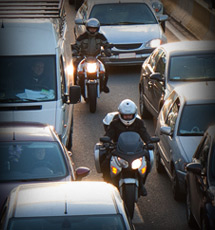|
|
|
|
| Share the road safely: Driving around motorcycles |
Did you know that more than half of all fatal motorcycle crashes involve another vehicle and most of the time the other vehicle is at fault? With summer approaching, the number of motorcycles on the road is increasing. Help share the road safely with motorcyclists using these tips. |
 |
|
| • Remember that motorcycles have the same rights and privileges as any other vehicle on the roadway. |
| • Always check your mirrors and blind spots for motorcycles before changing lanes and at intersections. They can be hidden in your blind spot due to their smaller size. It can also be difficult to judge their speed and distance as they approach due to their size. |
| • Always signal your intentions before changing lanes or merging with traffic to allow motorcyclists to anticipate traffic flow and find a safe lane position. |
| • Don’t be misled by a flashing turn signal on a motorcycle. They may not turn off automatically and motorcyclists sometimes forget to turn them off. Make sure the rider is going to turn before you proceed. |
| • Motorcyclists often change position within the lane for a purpose. It may be to increase visibility of their motorcycles by other vehicles or to minimize the effects of road debris, passing vehicles and wind. |
| • Road conditions that are minor issues to other vehicles can be major hazards to motorcyclists. They may change speed or adjust position within a lane suddenly in reaction to conditions such as potholes, wet or slippery surfaces and pavement seams. |
| • Increase your following distance an additional 3 – 4 seconds when following a motorcycle so the rider has enough time to maneuver or stop in an emergency. Motorcyclists often slow by downshifting or rolling off the throttle, meaning the brake light is not activated to alert you. Also remember that motorcycles can stop more quickly than cars in dry conditions. |
| • Do not attempt to share a lane with a motorcyclist, even if it seems like there is enough room for both vehicles. The motorcyclist needs room to maneuver safely. |
| For more tips on driving safely around motorcycles, visit Traffic Safety Marketing's Share the Road campaign or the Motorcycle Safety Foundation's quick tips for car drivers. |
| • Motorcyclist fatalities increased in 2011 to 4,612, accounting for 14 percent of total fatalities for the year. |
| • In 2011, 60 percent of fatally injured motorcycle riders and 49 percent of fatally injured motorcycle passengers were not wearing helmets at the time of the crash. |
| • Forty-two percent of the 1,997 motorcycle riders who died in single-vehicle crashes in 2011 had BAC levels of .08 or higher. Sixty-seven percent of those killed in single vehicle crashes on weekend nights had BACs of .08 or higher. |
| • In 2011, more than one-fifth of motorcycle riders (22%) involved in fatal crashes were riding with invalid licenses at the time of the collision. |
| • NHTSA estimates that helmets saved the lives of 1,617 motorcyclists in 2011. If all motorcyclists had worn helmets, an additional 703 lives could have been saved. |
| • The economic cost savings due to helmet use was approximately $3.4 billion in 2011 and an additional $1.4 billion could have been saved if all motorcyclists had worn helmets. |
|
|
|
|
|
|
